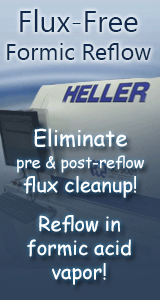Printed Circuit Board Assembly & PCB Design Forum
SMT electronics assembly manufacturing forum.
- SMTnet
- »
- Electronics Forum
- »
- Quick Turn Around for an EMS Provider - Brainstorming
Quick Turn Around for an EMS Provider - Brainstorming
Views: 4495
![]() With the High Volume Manufacturing in United States became l...
- Jan 12, 2009
by
smt_guy
With the High Volume Manufacturing in United States became l...
- Jan 12, 2009
by
smt_guy
![]()
![]()
![]() I've done it many times in the past and I would never recomm...
- Jan 12, 2009
by
emil
I've done it many times in the past and I would never recomm...
- Jan 12, 2009
by
emil
![]()
![]()
![]() What is the shift structure of your shop? If your facility h...
- Jan 15, 2009
by
Wolfman
What is the shift structure of your shop? If your facility h...
- Jan 15, 2009
by
Wolfman
![]()
![]()
![]() We do this quite regularly. In fact, it's a core part of ou...
- Jan 15, 2009
by
robgd3
We do this quite regularly. In fact, it's a core part of ou...
- Jan 15, 2009
by
robgd3
![]()
![]()
![]() I think it might be useful to differentiate between proto-ty...
- Jan 15, 2009
by
Wolfman
I think it might be useful to differentiate between proto-ty...
- Jan 15, 2009
by
Wolfman
![]()
![]()
![]() I'd agree. I wouldn't be able to turn significant volume in...
- Jan 15, 2009
by
robgd3
I'd agree. I wouldn't be able to turn significant volume in...
- Jan 15, 2009
by
robgd3
![]()
![]()
![]() Proper Prior Preparation Prevents Piss Poor Performance.
...
- Jan 19, 2009
by
alien
Proper Prior Preparation Prevents Piss Poor Performance.
...
- Jan 19, 2009
by
alien
![]()
![]()
![]() Thank you for the customer's perspective, Alien. We actually...
- Jan 19, 2009
by
Wolfman
Thank you for the customer's perspective, Alien. We actually...
- Jan 19, 2009
by
Wolfman
![]()
![]()
![]() Thank you very much guys. I really appreciate all your input...
- Jan 20, 2009
by
smt_guy
Thank you very much guys. I really appreciate all your input...
- Jan 20, 2009
by
smt_guy
![]()
![]()
![]() Start off by suggesting that they buy the parts as they're g...
- Jan 20, 2009
by
robgd3
Start off by suggesting that they buy the parts as they're g...
- Jan 20, 2009
by
robgd3
![]()
![]()
![]() Here's another question that I should have brought up earlie...
- Jan 20, 2009
by
Wolfman
Here's another question that I should have brought up earlie...
- Jan 20, 2009
by
Wolfman
![]()
![]()
![]() I totally agree with Wolfman. I recently had the SMA respons...
- Jan 21, 2009
by
lkpdsund
I totally agree with Wolfman. I recently had the SMA respons...
- Jan 21, 2009
by
lkpdsund
![]()
- SMTnet
- »
- Electronics Forum
- »
- Quick Turn Around for an EMS Provider - Brainstorming







